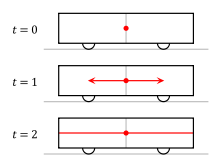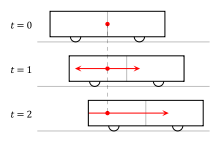Firstly a warm welcome to all new followers; we were fortunate enough to be featured on WordPress Discover recently which gave a wonderful flurry of new support. We endeavour to stay in touch and interact with as many of you as possible; and hope that science and mathematics continues to be an area of interest for everyone. The pool of human knowledge is after-all our most valuable asset, which we share collectively.
Now for our second exploration of time (if you missed the first you can find it here). The theory of relativity is our best theory of the macroscopic world. The theory of Special Relativity was introduced by Einstein in 1905 brought about a wide range of insights into the nature of reality including length contraction, time dilation, a universal speed limit of the speed of light and the relativity of simultaneity. It is the latter that shall interest us today.
Recall the familiar light beam on a train thought experiment? If not you can see a detailed explanation of it here. In brief; a beam flight is emitted from a bulb placed in the middle of the carriage on board a train – which is moving with a steady speed away from the platform. Due to the fixed, universal speed of light the observer on board the train will see the flashes of light hit the back and front of the carriage at the same time. This is because he is in the same reference frame as the train – relative to the observer on board, the train is stationary. However the observer watching from the platform will see light hit the back of the carriage before the front – as the light has (according to the observer on the platform) less distance to travel to reach the back of the carriage because the back of the carriage is also moving forwards in the direction of the bulb from his perspective. This is the relativity of simultaneity, the event ‘the light beam hits the back of the carriage’ occurs simultaneous with different things for the different observers. In a moment the on-board observer calls ‘now’ the beam hits the back and front simultaneously. In a moment the off-board observer calls ‘now’ the beam just hits the back. Now in our ordinary perspective of the universe and time there is a common, universal ‘now’ which we see as a cosmic wide present moment and during which we all agree on what is happening in that instant. Special relativity throws this intuitive notion out the window. What is happening ‘now’ becomes a judgement call made by an observer depending on their position and velocity in the universe. Believe it or not this is what special relativity is telling us about the nature of time – and seeing as it’s our best theory of the macroscopic world – we should take its implications seriously.

View point of the light beam from observer on board

View point of the light beam from observer on the platform
Now the reason we don’t have such disagreements about what’s happening ‘now’ with our neighbours is because such effects only cause discrepancies with signals of very high speed i.e. the light beam or on extremely large distances – we’re talking intergalactic. So sadly you can’t put down your lateness to meeting a friend as a consequence of the differing idea of ‘now’ (though this would be the best excuse i’d ever heard). Here is the famous Andromeda Paradox by mathematician Roger Penrose that extends this phenomena to the judgement of events very far away. The argument uses the tool of the Spacetime diagram as an aid but I will try and explain it without a such a concept in this post.
There are two people walking past each other in the street. One is walking in the direction of the Andromeda galaxy, and the other is walking away. Now the technical terminology for what comprises now for a certain observer is the set of events that lie on their ‘plane of simultaneity.’ A plane of simultaneity is in essence the collection of events that comprise the three-dimensional universe for that particular observer, in their experience of the present moment. For example I am sitting here in my room typing this, I see the curtain blowing in the wind, the noise of the birds, a shooting star crossing the night sky – all these events lie on my plane of simultaneity. However, for other observers moving at different velocities to me our planes of simultaneity differ slightly. The velocities are not big enough to cause an difference over what we regard as happening ‘now’ in the local vicinity but if you extrapolate these planes far far out, out to intergalactic distances the slightest movement left or right can cause the observer’s three-dimensional universe to have differing content. This is all part of the big idea of spacetime. (A post of spacetime and spacetime diagrams coming soon) Back to the paradox – so for the observer walking towards the galaxy the events in occurring in Andromeda on their plane of simultaneity may be hours or days or weeks in advance of that for the observer walking away. If on Andromeda they are planning an invasion on Earth, for the observer walking away they may still be planing but for the observer walking towards they may already have left!
Now I know you must be thinking but these observers can’t possible receive signals from such inter-galactic distances or ‘see’ what’s going on in the first place to have the evidence to compare. But this is the beauty of thought experiments and the basis of theoretical physics. This is what the theory tells us about the nature of time when extrapolated to boundaries beyond the ability of our tiny human probes, and seeing as this theory has been stood the test of all our experiments so far we should take its wider consequences seriously.
The fundamental axiom of Special Relativity is that no reference frame is preferable over any other. As such no observer has the right to claim his experienced present moment is the ‘real’ now. Therefore if there is no distinguished, cosmic, fundamental ‘now’ we can no longer clearly divide events into past and future, using the now as the unambiguous barrier. Time and its once rigid tenses begin to disintegrate and crumble beneath us. The once solid passage of time and the idea of a cosmic now moving ever forwards and clearly bringing future events to present and present events to past is no more. Each observer has their own set of present events that they consider to be make up the three-dimensional universe. But each is different and thus with these multiple different three-dimensional universe we reach the conclusion that the universe is four-dimensional. Now four dimensions are very hard to imagine or visualise so for the sake of our human brains imagine the analogy but with one dimension less. The universes of the observers are like different two-dimensional slices or cross sections through a three-dimensional block or cube.

The four dimensions of this block are the three of space and the one of time and within this four-dimensional block universe are all the events that ever existed, exist or will exist. The block universe theory states all events from the birth to the death of the universe and everything in between ‘pre-exist’ in the block. There is now cosmic now but only a present plane of simultaneity from the perspective of observers who float through the block. All events behind the floating observer are regarding as past from them, all ahead as future and as the observer floats through his life he cuts slices through the block, parallel to his trajectory which represent his present set of affairs.
So there we have it, the nature of time according to Special Relativity and the four-dimensional block universe theory. No fundamental passage of time, no cosmic-wide now just perspectives of three-dimensional beings in a four-dimensional block. If that doesn’t blow your mind, I don’t know what would. Although, the theory does give me some weird sort of comfort and it seems to have done for Einstein as well as he said to his friend after the death of her husband “now he has departed from this strange world a little ahead of me. That signifies nothing. For those of us who believe in physics, the distinction between past, present and future is only a stubbornly persistent illusion.”
I hope I managed to convey this theory and it’s consequences with some clarity – confusion around such a counter-intuitive subject is of course to be expected. There are however theories that try to salvage the fundamental passage of time and universal present moment even in light of the theory of Special Relativity… In fact I wrote my thesis on this topic with the conclusions the present moment does after all exist! I’ll let you in on my thoughts on that reassuring idea in the future.

Pingback: What’s the ‘Proper Time’? | Rationalising The Universe·
Pingback: What’s the ‘Proper Time’?·
Pingback: Time and Being: Part II | Blank Horizons·